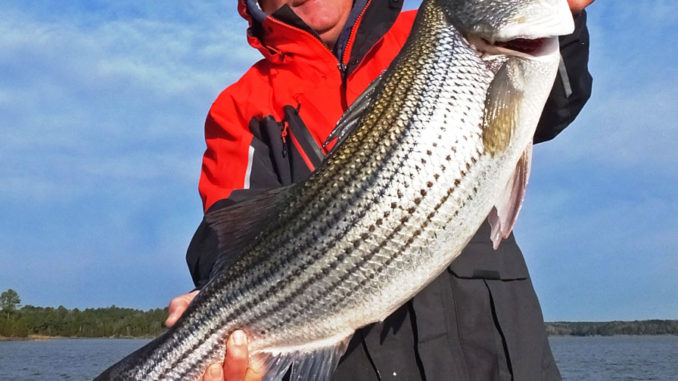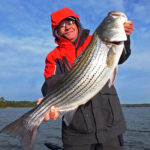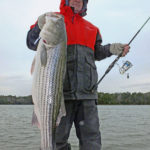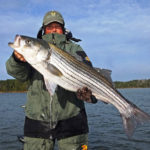
The unmatched trophy striped bass fishery on Lake Russell comes alive this month as winter brings out the best in huge fish.
There’s a time and place for everything, things to think about for just about any endeavor, including the search for trophy fish. For anglers looking to target trophy striped bass, the time is now, and the place is most certainly South Carolina’s Lake Richard Russell.
The lake is managed with a two-fish daily limit, far below the 10-fish limits at Clarks Hill downstream or Lake Hartwell upstream, a regulation that guide Jerry Kotal said was specifically implemented to promote a trophy fishery.
“The striper fishery at Lake Russell is working well for sportsmen targeting huge stripers,” he said. “The potential to catch trophy stripers exists anytime you’re fishing. I’ve spent extensive effort over the past several years and found the mid-December through January time period is the absolute best to consistently catch huge stripers. When conditions are right, the opportunities to catch multiple big fish on an given day are quite realistic.”
Kotal said the definition of a trophy striper varies by region and reservoir, but he and Wendell Wilson, another Lake Russell guide, consider 25 pounds as a benchmark, and Kotal said the potential to catch stripers weighing 30 pounds or more is well within play.
“My top fish from Russell is 47 pounds, but I have hooked fish much larger,” he said. “We’ve caught multiple fish over 30 pounds on several days over the past few years. As with any trophy species of fish or game in the wild, it’s never a sure thing, but Lake Russell at this time of year is as good as I’ve found in our area.”
Kotal and Wilson work with each other to keep tabs on stripers, but their fishing styles are considerably different. Wilson primarily fishes live bait for stripers while Kotal thrives on casting artificial lures.
“We’ll certainly both do whatever we need to do to have the best chance of catching big stripers,” Wilson said, “but I prefer to go the live-bait route, and that’s partly a function of how I like to fish. I’ve developed my pattern for finding and catching fish with live bait.”
Kotal said his strategy stems from his love of tournament bass fishing. He’ll work artificial lures in a variety of depths and locations seeking the big fish bite.
For both guides, the effort begins with finding the fish.
Wilson said winter stripers will typically be in the mid-lake area down to the dam, but no hard and fast rule exists.
“I like the Beaver Dam Creek and Rocky River areas of the lake and towards the lower end of the lake,” Wilson said. “Stripers are travelers, and they tend to move around a lot, but it’s forage-related movement. The one constant is they are found around forage, and that’s the key: find the big bunches of forage and fish that area.”
Wilson said he’ll use his electronics to isolate big clusters of forage as well as to pinpoint precise location and depth of stripers. If he gets a specific depth of individual fish, he’ll target that depth. He knows he’s not going to see all the stripers in an area with one or two passes over an area, so he’ll have baits working different depths as well as targeting marked fish.
Wilson fishes in areas where he’s been catching fish — that’s his starting point — but he’ll consider wind direction and speed in terms of the possibility of forage moving to a specific area of the 26,650-acre lake.
“I’ll target points, humps and ledges as broad targets and specifically search for stripers suspended around well-defined areas of forage,” he said. “I want to see a very consistent bait line when looking for big stripers. When I find this and mark fish, I think are big stripers I’ll fish vertically as well as use the wind or trolling motor to slowly move the boat. I’ll pull baits out of the back of the boat, weighted to get down to different depths depending on where the fish are marked on the graph.”
Wilson said fish will hold in a specific place all-day long and occasionally be found in the same vicinity for multiple days if weather patterns remain stable. But the reality is, he is prepared to hunt for them every day he takes to the water.
“A key to successfully targeting these big fish is to stay on the move and hunt them down,” he said. “It can be a game of patience and perseverance.”
Wilson said the temperature impacts his choice of bait; when the surface water temperature dips below 50 degrees, he’ll usually turn to smaller baits. He’ll always have live herring, but he’ll also have 3- to 5-inch shiners on hand.
“I’ve found herring to be better when the water is warmer, but when the water temperature dips below 50 degrees, I’ll often use shiners along with herring,” he said. “They are hardy and will live and move better in very cold water, and lively bait is crucial for hooking these big stripers. I’ll drop the bait to or just above the depth I target. To cover the area thoroughly, I’ll fish some baits a little shallower and a bit deeper as well.”
Wilson employs serous tackle for this fishing: 7-foot, heavy action baitcasting rods and reels loaded with 65-pound braid.He’ll have a 3-foot leader of 40-pound fluorocarbon, with a 2/0 Eagle Claw style 084 hook, below a sinker of up to two ounces, depending on depth and wind conditions.
Kotal takes the same route to finding and staying on fish, but his tactic of choice is casting artificial lures.
“I love to hook huge stripers on artificial lures, but to enhance my odds, I’ll make sure I’ve got fish in the area before I cast,” he said. “I’ll use a variety of lures; bucktails, swimbaits and jigging spoons are all excellent choices.
“Stripers have different lure preferences on some days, based on weather, water conditions and water temperature. I’ll experiment with a variety of lures and speeds until I figure the daily pattern. The speed of retrieve on big bucktails or swimbaits will vary, but generally in the cold water, I’d characterize it as slow.
“Sometimes, I have to work the lure just over the tops of submerged trees when the stripers are holding in those places. Ideally, I like to find them over open water, because we’ll have a better chance of landing the really big ones. But with these fish, you simply have to deal with the situation and fish where you find them.”
Kotal said stripers will work the surface occasionally, and seeing gull activity over feeding fish is another way to get on the big stripers.
“When I see gull activity in really cold weather, I get super-charged,” he said. “The stripers will often just roll on the small threadfin shad. I’m always watching for this because it’s an ideal opportunity to find fish in reasonably shallow water and be able to catch multiple fish quickly with artificial lures.
“When I find this situation in late December and through January, I really expect us to get bit by quality stripers. It doesn’t happen enough to dedicate the day to it as the primary pattern, but I am always watching because it’s a game-changer when it occurs.”
When the surface activity slows, Kotal will use his graph to locate stripers that typically linger in that vicinity, and he’ll continue casting. He’ll typically fish deeper, letting the lure sink to the depth where fish are marked or just above. Also, vertically fishing live bait in this situation offers a great opportunity for a quick hookup.
Kotal said winter is his favorite time to hook a huge striper.
“I’d say the chances of catching a 20- to 30-pound striper are very realistic on any given day,” he said. “Of course, it’s not going to happen every day, but that’s my realistic goal. Catching a 30-pound plus striper is a reasonable goal, and we’ll have days with multiple fish over 30 pounds. A 40-pound striper is certainly possible, and we usually catch a few a year, but these are much harder to come by. But the potential of topping the current state record from this lake is always on my mind.”
DESTINATION INFORMATION
HOW TO GET THERE — Lake Russell lies on the Georgia-South Carolina line, southwest of Abbeville in Anderson and Abbeville counties. SC 81 and SC 72 provide the best access. Top public ramps are Milwood, southwest of Calhoun Falls off SC 81; Calhoun Falls State off SC 81; Beer Garden Creek, south of Calhoun Falls of SC 81; Blue Hole, west of Calhoun Falls of SC 81; Felkel, southwest of Lowndesville off CR 74; Wilson Creek, north of Lowndesville off CR 72; Allen Creek, west of Lowndesville, off CR 70.
WHEN TO GO — Mid-December through January is considered prime time to wrestle with a trophy striper at Lake Russell.
BEST TECHNIQUES — Fish the lower end of the lake when the water temperature falls below 50 degrees. Use your electronics to locate big pods of baitfish and the stripers that wlll be accompanying them. Fish live bait vertically just above the depth where stripers are marked, or fish bucktails or jigging spoons vertically or swim a swimbait through the stripers. Heavy tackle is required to work these big fish.
FISHING INFO/GUIDES — Wendell Wilson, Wilson’s Guide Service, 706-283-3336; www.wilsonsguideservice.com; Jerry Kotal, Jerry Kotal’s Fishing Guide Service, 706-988-0860, www.jerrykotalsfishingguideservice.com; Sportsman’s One Stop, Iva, 864-348-2840. See also Guides and Charters in Classifieds.
ACCOMMODATIONS — Econo Lodge, Elberton, Ga., 888-690-5281; Days Inn, Elberton, Ga., 800-230-4134; Calhoun Falls State Park camping, 864-447-8267; www.southcarolinaparks.com/calhounfalls/camping.aspx.
MAPS — Kingfisher Maps, 800-326-0257, www.kfmaps.com; Delorme South Carolina Atlas & Gazetteer, 800-561-5105, www.delorme.com.





Be the first to comment